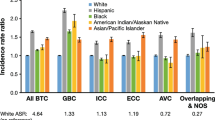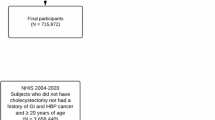Abstract
Objective
Few investigations of biliary tract (gallbladder, extrahepatic bile duct, ampulla of Vater) cancers have been conducted because of the relative rarity of these malignancies. The objective of this analysis was to compare the demographic, pathological, and clinical features of biliary tract cancers among men and women.
Methods
Biliary tract cancers among 11,261 men and 15,722 women were identified through 33 US population-based registries during the period 1997–2002. These registries were estimated to represent 61% of the US population. Age-adjusted incidence rates (AAIR) were calculated per 100,000 population using counts derived from the 2000 US census.
Results
The AAIR for gallbladder cancer among men (0.82 per 100,000) was significantly lower than the AAIR among women (1.45 per 100,000). By contrast, rates for extrahepatic bile duct and ampullary cancers were significantly higher among men (0.93 per 100,000 and 0.70 per 100,000, respectively) than among women (0.61 per 100,000 and 0.45 per 100,000, respectively). White men and women had significantly lower AAIRs for gallbladder cancer compared with other racial-ethnic groups, with the highest rates among Hispanics, American Indian-Alaska Natives, and Asian-Pacific Islanders. Asian-Pacific Islanders and Hispanics of both sexes had the highest AAIRs for extrahepatic bile duct and ampullary cancers. Ampullary tumors were more likely to be diagnosed at a localized or regional stage than were cancers of the gallbladder and extrahepatic bile duct. Asian-Pacific Islander men and women tended to have more unstaged cancers than other groups.
Conclusions
This population-based study suggests distinct etiologies of anatomic subsites of biliary tract cancer and caution against analytic investigations of all biliary tract cancers combined.




Similar content being viewed by others
References
Khan ZR, Neugat AI, Ahasan H, Chabot JA (1999) Risk factors for biliary tract cancers. Am J Gastroenterol 94:149–152
Chow W-H, McLaughlin JK, Menck HR, Mack TM (1994) Risk factors for extrahepatic bile duct cancers: Los Angeles County, California (USA). Cancer Cause Control 5:267–272
Lowenfels AB, Maisonneuve P, Boyle P, Zatonski WA (1999) Epidemiology of gallbladder cancer. Hepatogastroenterology 46:1529–1532
Misra S, Chaturvedi A, Misra NC, Sharma ID (2003) Carcinoma of the gallbladder. Lancet Oncol 4:167–176
Lazcano-Ponce EC, Miqual JF, Munoz N, et al (2001) Epidemiology and molecular pathology of gallbladder cancer. Ca Cancer J Clin 51:349–364
Ekbom A, Hsieh CC, Yuen J, Trichopoulos D, McLaughlin JK, et al (1993) Risk of extrahepatic bile duct cancer after cholecystectomy. Lancet 342:1262–1265
Yeh S, Hsieh CC, MacMahon B (1987) Extrahepatic bile duct cancer and smoking, beverage consumption, past medical history, and oral contraceptive pill use. Cancer 59:2112–2116
Zhang XH, Andreotti G, Gao YT, Deng J, Liu E, Rashid A, Wu K, Sun L, Sakoda LC, Cheng JR, Shen MC, Wang BS, Han TQ, Zhang BH, Gridley G, Fraumeni JF Jr, Hsing AW (2006) Tea drinking and the risk of biliary tract cancers and biliary stones: a population-based case-control study in Shanghai, China. Int J Cancer 118:3089–3094
Bergquist A, Ekbom A, Olsson R, Kornfeldt D, Loof L, Danielsson A, Hultcrantz R, Lindgren S, Prytz H, Sandberg-Gertzen H, Almer S, Granath F, Broome U (2002) Hepatic and extrahepatic malignancies in primary sclerosing cholangitis. J Hepatol 36:321–327
Sakoda LC, Gao YT, Chen BE, Chen J, Rosenberg PS, Rashid A, Deng J, Shen MC, Wang BS, Han TQ, Zhang BH, Cohen-Webb H, Yeager M, Welch R, Chanock S, Fraumeni JF Jr, Hsing AW. (2006) Prostaglandin-endoperoxide synthase 2 (PTGS2) gene polymorphisms and risk of biliary tract cancer and gallstones: a population-based study in Shanghai, China. Carcinogenesis 27:1251–1256
Gonzalez-Perez A, Garcia Rodriguez LA, Lopez-Ridaura R (2003) Effects of non-steroidal anti-inflammatory drugs on cancer sites other than the colon and rectum: a meta-analysis BMC. Cancer 3:28
Parkin DM, Whelan Sl, Ferlay J, et al (eds) (1997) Cancer incidence in five continents, volume VII. Lyon: International Agency for Research on Cancer. IARC Sci. Pubs. No. 143
Everhart JE (2001) Gallstones and ethnicity in the Americas. J Assoc Acad Minor Phys 12:137–143
Black WC, Key CR, Carmany TB, Herman D (1977) Carcinoma of the gallbladder in a population of Southwestern American Indians. Cancer 39:1267–1279
US Cancer Statistics Working Group. United States Cancer Statistics: 2001 Incidence and Mortality. Atlanta (GA): DHHS, CDC and NCI, 2004
Howe HL, Chen VW, Hotes J, Wu XC, Correa C, Fulton JP (eds) (2001) Cancer Incidence in North America 1994–1998, Volume One: Incidence. Springfield, IL. North American Association of Central Cancer Registries
NAACCR. Report of the NAACCR Expert Panel on Hispanic Identification 2003. North American Association of Central Cancer Registries: Springfield, IL. Also available from URL http://www.naaccr.org, 2004
Fritz A, Percy C, Jack A, et al (2000) International Classification of Disease for Oncology. 3rd edition. World Health Organization, Geneva
Young J, Roffers S, Ries L, Fritz A, Hurlburt AE (eds) (2001) SEER Summary Staging Manual, 2000. Codes and Coding Instructions. Bethesda, MD: National Institutes of Health, National Cancer Institute
SEER*Stat 2001. Bethesda, MD: National Cancer Institute. Also available from URL: http://seer.cancer.gov/seerstat [accessed 2003, January13], 2003
US Census Bureau. United States Census 2000. Also available from URL: http://www.census.gov/population/www/ [accessed 2004, September 3]
Levi F, Lucchini F, Negri E, La Vecchia C (2003) The recent decline in gallbladder cancer mortality in Europe. Eur J Cancer Prev 12:265–267
Wood R, Fraser LA, Brewster DH, Garden OJ (2003) Epidemiology of gallbladder cancer and trends in cholecystectomy rates in Scotland, 1968–1998. Eur J Cancer 39:2080–2086
Randi G, Franceschi S, La Vecchia C (2006) Gallbladder cancer worldwide: geographical distribution and risk factors. Int J Cancer 118:1591–1602
Barakat J, Dunkelberg JC, Ma TY (2006) Changing patterns of gallbladder carcinoma in New Mexico. Cancer 106:434–440
Das A, Neugut AI, Cooper GS, Chak A (2004) Association of ampullary and colorectal malignancies. Cancer 100:524–530
Ries LAG, Harkins D, Krapcho M, Mariotto A, Miller BA, Feuer EJ, Clegg L, Eisner MP, Horner MJ, Howlader N, Hayat M, Hankey BF, Edwards BK (eds) (2006) SEER Cancer Statistics Review, 1975–2003, National Cancer Institute. Bethesda, MD, http://seer.cancer.gov/csr/1975_2003/, based on November 2005 SEER data submission, posted to the SEER web site
Hsing AW, Gao YT, Devesa SS, Jin F, Fraumeni JF Jr (1998) Rising incidence of biliary tract cancers in Shanghai, China. Int J Cancer 75:368–370
Altschuler EL (1999) Adenocarcinoma of the ampulla of Vater. Ann Surg 230:450
Chow WH, Johansen C, Gridley G, Mellemkjaer L, Olsen JH, Fraumeni JF Jr (1999) Gallstones, cholecystectomy and risk of cancers of the liver, biliary tract and pancreas. Br J Cancer 79:640–644
O’Malley C, Hu KU, West DW. North American Association of Central Cancer Registries: race and ethnicity identifier assessment project (2002). Also available from URL http://www.naaccr.org
Kolonel LN, Goodman MT (1992) Racial variation in cancer: fact or artifact?. J Natl Cancer Inst 84:916–917
Acknowledgments
Supported in part by the Centers for Disease Control and Prevention under Cooperative agreement U75/CCU515998 to the North American Association of Cancer Registries, and the National cancer Institute’s SEER Program under contract N01-CN-67001 form the National Institutes of Health, Department of Health and Human Services.
Author information
Authors and Affiliations
Corresponding author
Rights and permissions
About this article
Cite this article
Goodman, M.T., Yamamoto, J. Descriptive study of gallbladder, extrahepatic bile duct, and ampullary cancers in the United States, 1997–2002. Cancer Causes Control 18, 415–422 (2007). https://doi.org/10.1007/s10552-006-0109-4
Received:
Accepted:
Published:
Issue Date:
DOI: https://doi.org/10.1007/s10552-006-0109-4




